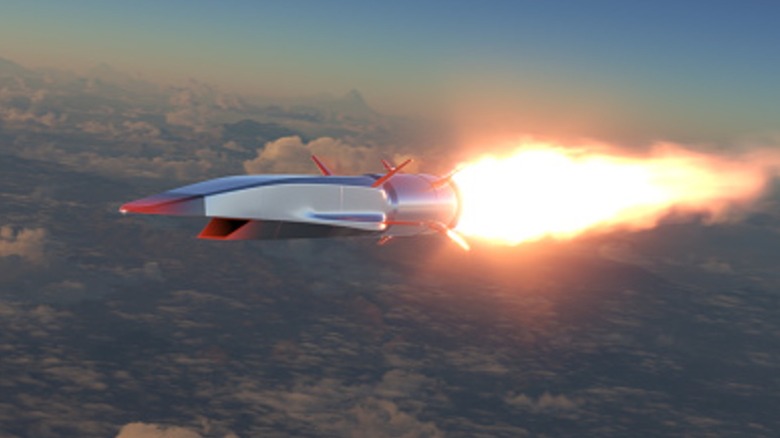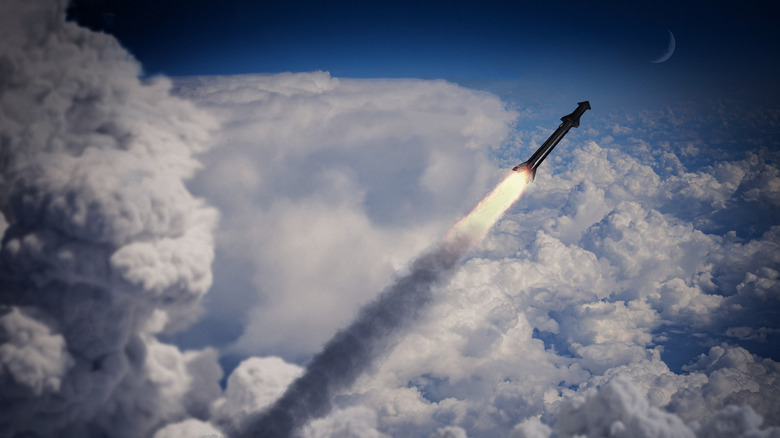Which Countries Have The Most Hypersonic Missiles In Their Military?
The United States can be considered the leading military force in the whole world, but there are certain technologies other countries are pulling ahead in, giving them a significant advantage. Hypersonic missile technology is such a technology. Hypersonic weapons are classified as weapons that can travel five times as fast as the speed of sound or faster. There are 11 countries developing hypersonic missiles and of those 11, China has been the most aggressive with its development. China launched a newer missile in 2023 that circumnavigated the globe at 15,000 miles per hour, 20 times faster than the speed of sound. That's not an insignificant advancement and better than anything the U.S. currently has on hand.
As of 2023, the Chinese military has developed five hypersonic missiles with a sixth in the prototype phase. China's most significant hypersonic weapon is the DF-ZF hypersonic glide missile, a warhead attached to the DF-17 rocket. The DF-17 cruises at roughly 60,000 feet but before it reaches the target, it releases the DF-ZF to glide the rest of the way over Mach 5. As if the internal explosives within the warhead weren't devastating enough, the speed of a mile per second coupled with the DF-ZF's mass would be catastrophic for any target. The prototype missile, the Starry Sky-2, is a nuclear capable missile. A nuclear missile that can evade defensive systems certainly does put China ahead in any potential arms race.
What other countries are developing hypersonic missiles?
China is not alone in the development of hypersonic missiles. Quite simply, when one world super power starts working on weapons advancement, many others always follow suit. The United States has not been as lucky with its development of the technology, despite investing billions of dollars in the research –$5 billion in 2023's budget. John Hyten, former vice chair of the Joint Chiefs of Staff said, "My concern about the lack of progress on hypersonics is only increasing," according to the Wall Street Journal. The only missile the U.S. has completed is the Operational Fires ground-launched system but has five others still in the works.
Russia started its hypersonic research and development during the Cold War in the '80s and has been using that research ever since. It might be considered outdated research, but it has completed four missiles with another three in development. Avangard is the country's hypersonic boost-glide vehicle that attaches to its existing ICBMs. It can carry a two-megaton warhead capable of more destruction than the bomb dropped on Hiroshima. More impressive is its Zircon missile, the first hypersonic cruise missile that propels itself with a supersonic combustion ramjet engine otherwise known as a scramjet, reaching nine times the speed of sound. Russia has used some against Ukraine.
France, India, North Korea, and Iran have all completed development of at least one hypersonic missile/glide vehicle while the U.K., Japan, South Korea, and Brazil have one or more still in development.
Why are hypersonic missiles such a threat?
There are multiple types of missiles that the largest global superpowers have at their disposal. There's the Ballistic Missile –there are four types of ballistic missiles– and the cruise missile. Authors of a 2021 report wrote, "Hypersonic weaponry represents the most significant advancement in missile technology since ICBMs," according to Popular Mechanics. Ballistic missiles are capable of reaching high speeds comparable to hypersonic missiles because their flight path takes them high into Earth's atmosphere where there's less drag. Unfortunately, their paths are predictable, making them easy targets to shoot down.
Cruise missiles fly lower and can evade some aerial defenses, but they're slower than their counterparts. There are some cruise missiles that are fast, but few reach hypersonic speeds. Hypersonic missiles are a happy medium of the three, flying at supersonic speeds with unpredictable maneuverability at low altitudes. Flying more than Mach 5 is an obvious concern for sovereign nations everywhere because not only do they reach their targets quickly, they can also avoid most air defenses. However, America is working with Japan to develop defensive systems that can target and take out hypersonic missiles. Unfortunately, those missile defense systems won't be ready for another decade.


